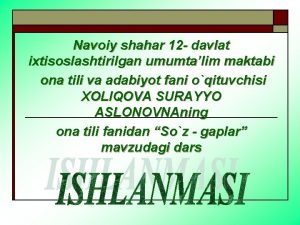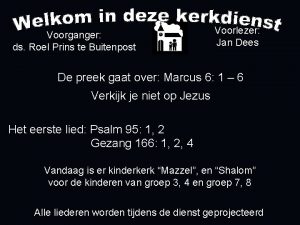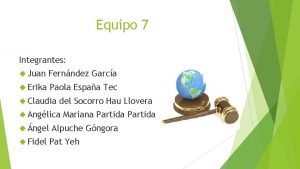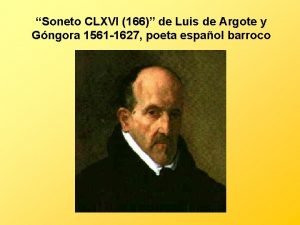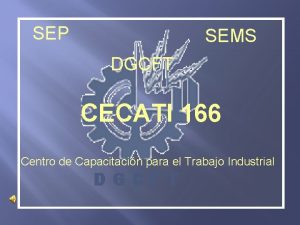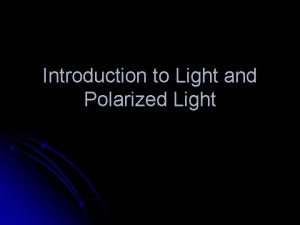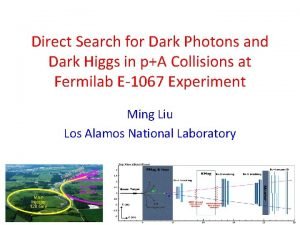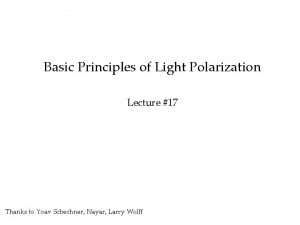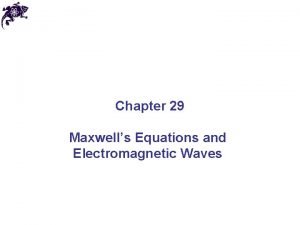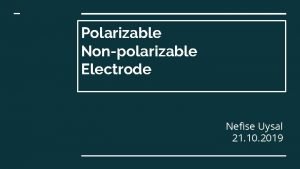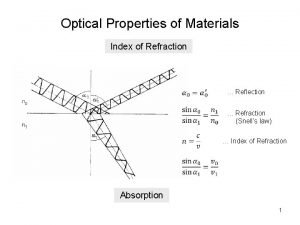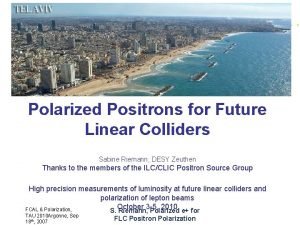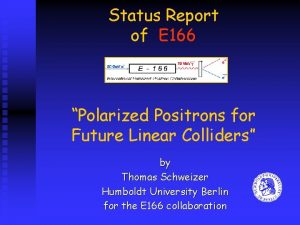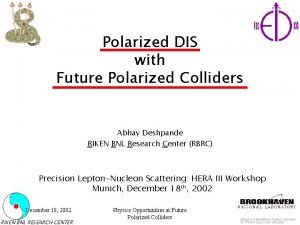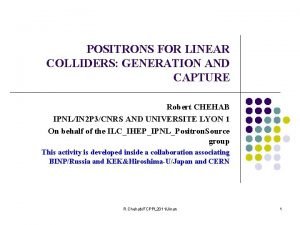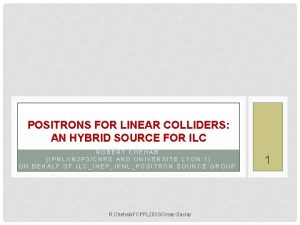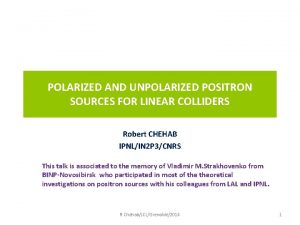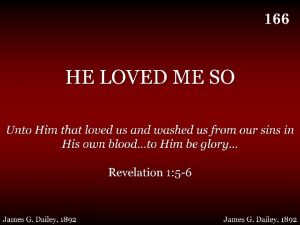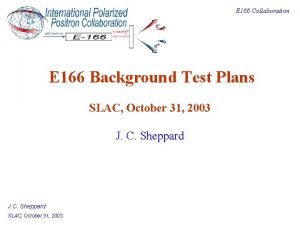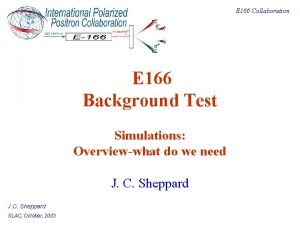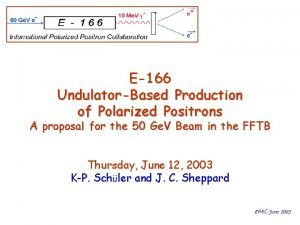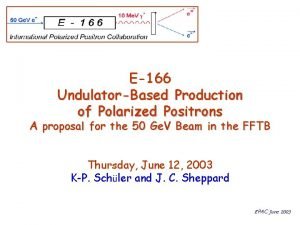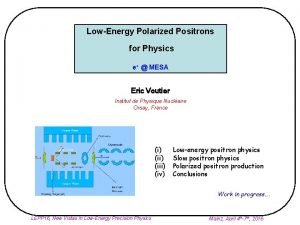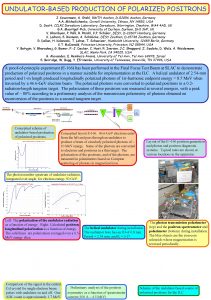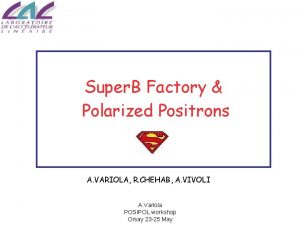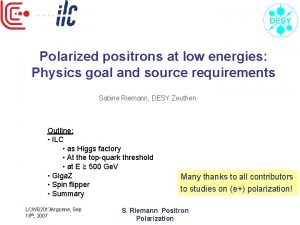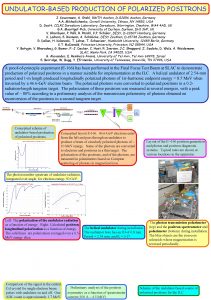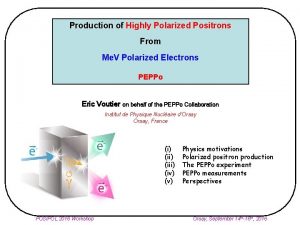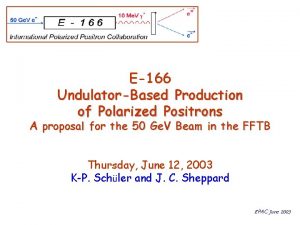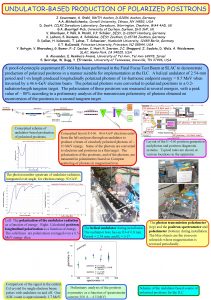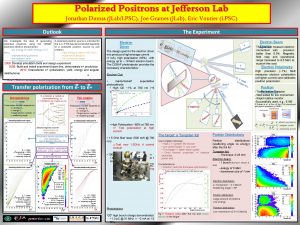E 166 Polarized Positrons for Future Linear Colliders







































- Slides: 39

E 166 “Polarized Positrons for Future Linear Colliders” John C. Sheppard E 166 Co-spokesman SLAC: August 31, 2004

Introduction • • • Overview and purpose of E 166 Experimental Setup Status & Milestones

Collaboration • About 45+2 members from 16+1 institutions from all three regions (Asia, Europe, the Americas, and Daresbury) • John Sheppard, Kirk Mc. Donald (co-spokesmen)

Overview of E 166 • • • Demonstration experiment for production of polarized e+ FFTB at SLAC with 50 Ge. V, 1010 e-/pulse , 30 Hz 1 m long helical undulator produces circular polarized radiation 0 -10 Me. V Conversion of photons to positrons in 0. 5 rad Ti-target Measurement of polarization of positrons by Compton transmission method Idea from Alexander Michailichenko 4

Polarized positrons at linear colliders • • The >150 Ge. V electron beam itself is used for the production of polarized positrons Electron beam passes a 200 m helical undulator (50% surplus) After conversion, the positrons are captured and accelerated They collide with a subsequent bunch train

E-166 Experiment E-166 is a demonstration of undulator-based production of polarized positrons for linear colliders: - Photons are produced in the same energy range and polarization characteristics as for a linear collider; -The same target thickness and material are used as in the linear collider; -The polarization of the produced positrons is expected to be in the same range as in a linear collider. -The simulation tools are the same as those being used to design the polarized positron system for a linear collider. - However, the intensity per pulse is low by a factor of 2000.

TESLA, NLC/USLCSG, and E-166 Positron Production ILC/ ILC

E 166 Equipment

E 166 Undulator Area

Spectrometer Area

Beam Intensities & Energies • 1010 electrons/bunch @ 50 Ge. V into the undulator 5 x 106 ph. E 4 x 109 photons @ < 10 Me. V 5 x 104 ph. E 4 x 109 photons 2 x 107 e+ 4 x 107 photons ~ 500 Te. V 4 x 105 e+ 1 x 103 photons of total ~ 5 Ge. V (~ 5 Me. V)

The helical undulator • • Rotating magnetic field Wire winded helically Inner diameter 0. 89 mm Magnetic field: 0. 76 T Pulsed current: 2300 A Rate 30 Hz 1010 e-/pulse incident Parameter NLC E 166 Length 240 m 1 m Beam 150 Ge. V Period 10 mm 2. 4 mm Strength K 1 0. 17 Cutoff ~10 Me. V 9. 6 Me. V Positrons 3 x 1010 2 x 107

Undulator radiation • Produced photons, cutoff and polarization Energy spectrum Polarization +1 5 Me. V -1

Target and spectrometer Material Polarization Ti 0. 25 rad. 52 % Ti 0. 5 rad. 53 % W-Re 0. 5 rad. 49 % With Photons from Undulator Polarization / d. N/d. E • Target: Ti or W-Re, yield 0. 5 % Energy spectrometer: spread 20% Positron energy (Me. V) 5 Me. V Extraction Counts • Pos. energy (Me. V)

Cs. I Calorimeter • • • „DESY Zeuthen and Humboldt University Berlin“ Pack 3 x 3 crystals in a stack Cs. I crystals: ~ 6 cm X 28 cm from DESY ~1000 Re-converted photons -> Max 5 Ge. V Readout by PIN diodes (large linear dynamic range) 14 degrees aparture Magnet e+ W-Target

Aerogel flux counters and Si-W calorimeter • Aerogel energy threshold: 4. 3 Me. V Ø • Photon flux measurement Si-W calorimeter Ø Ø Ø 4 x 4 Stack of 20 plates of W (1 rad. length thickness) Up to 500 Te. V signal Total energy of undulator photons

Status of Subcomponents Component Status Helical undulator 1. 0 m prototype „Cornell University“ Positron transport system In design Institution „Princeton University“ Analyzer magnets In construction „DESY Hamburg“ Cs. I calorimeter Prototype, „DESY Zeuthen/ In construction Humboldt Unversity Berlin Si-W calorimeter Ready „University Tenessee“ Aerogel counters Ready „Princeton University“ DAQ and Readout Ready „SLAC“ In Discussion „E 166“ Data Analysis

E 166 Milestones

E 166 Schedule • Now thru October 1, 2004: Ø Ø • October 1 st thru November 1 st : Ø • Develop DAQ (T 467) Develop/build equipment Install Equipment Pre. Beam Equipment Checkout, Backgrounds, Initial Data Run January 1 st thru February 1 st, 2005 : Ø Checkout, Backgrounds, Initial Data Run

E-166 Beamline Schematic 50 Ge. V, low emittance electron beam 2. 4 mm period, K=0. 17, helical undulator 10 Me. V, polarized photons 0. 5 r. l. converter target 51%-54% positron polarization Moffeit/Woods

E-166 Beam Request The SLAC FFTB: • Built to Demonstrate LC FFS: 60 -70 nm rms spot • 28 - 50 Ge. V Beam Energy • e = 1. 5 x 10 -5/ 1. 5 x 10 -6 m-rad (x/y) • sz = 50 -500 mm • Nb = 0. 1 -4 x 1010 e-/bunch • 2. 5 k. W Power Limit (1 x 1010 @ 30 Hz and 50 Ge. V) • 1 W Continuous Beam Loss Limit

SLAC FFTB

SLAC FFTB

E 166 FFTB Tunnel 1

E 166 FFTB Tunnel 2

E 166 FFTB Optics, RHI

E 166 PS: B 406

E 166 DAQ: B 407

E 166 Cs. I and Electronics, B 407

E 166 Cs. I and Electronics, B 407

SLAC FFTB, IP 1

SLAC FFTB: B 06 G, PC 7. 5

SLAC FFTB: Det. Tables

SLAC FFTB Table

Cornell: Undulators

DESY-HH: Analyzer Magnets

E-166 Beam Measurements • Photon flux and polarization as a function of K. • Positron flux and polarization for K=0. 17, 0. 5 r. l. of Ti vs. energy. • Positron flux and polarization for 0. 1 r. l. and 0. 25 r. l. Ti and 0. 1, 0. 25, and 0. 5 r. l. W targets. • Each measurement is expected to take about 20 minutes. • A relative polarization measurement of 10% is sufficient to validate the polarized positron production processes

Conclusions • • • E 166 is a demonstration of production of polarized positrons for future linear colliders Uses the 50 Ge. V FFTB at SLAC Approved by SLAC in June 2003 • Installation of total experiment in FFTB tunnel in August, September, October(? ) 2004 • First data taking run in October 2004 Second data taking run in January 2005 •

The end …
 Future continuous tense and future perfect exercises
Future continuous tense and future perfect exercises Future continuous and future perfect
Future continuous and future perfect Navoiy shahar 10-maktab
Navoiy shahar 10-maktab Gezang 166
Gezang 166 Ley general del ambiente
Ley general del ambiente Fas 166
Fas 166 Luis de argote y gongora soneto clxvi
Luis de argote y gongora soneto clxvi Cecati 166
Cecati 166 Properties of light definition
Properties of light definition Dark sector upgrades
Dark sector upgrades Polarized wave
Polarized wave Polarized pluralist model
Polarized pluralist model Brain homunculus
Brain homunculus Ampere maxwell law
Ampere maxwell law Ideal polarizable electrode
Ideal polarizable electrode Polarized wave
Polarized wave 1 2 3 kondicional u engleskom jeziku
1 2 3 kondicional u engleskom jeziku See future continuous
See future continuous Tenses summary
Tenses summary Future nurse future midwife
Future nurse future midwife Future plans and finished future actions
Future plans and finished future actions Future perfect interrogative
Future perfect interrogative Continuous future in the past
Continuous future in the past Future perfect future perfect continuous
Future perfect future perfect continuous Rules of tense
Rules of tense Present progressive of plan
Present progressive of plan Tack för att ni har lyssnat
Tack för att ni har lyssnat Smärtskolan kunskap för livet
Smärtskolan kunskap för livet Trög för kemist
Trög för kemist Karttecken höjdkurva
Karttecken höjdkurva Epiteltyper
Epiteltyper Matte större än tecken
Matte större än tecken Magnetsjukhus
Magnetsjukhus Returpilarna
Returpilarna Personalliggare bygg undantag
Personalliggare bygg undantag Toppslätskivling effekt
Toppslätskivling effekt Borra hål för knoppar
Borra hål för knoppar Bris för vuxna
Bris för vuxna Mat för idrottare
Mat för idrottare Publik sektor
Publik sektor


